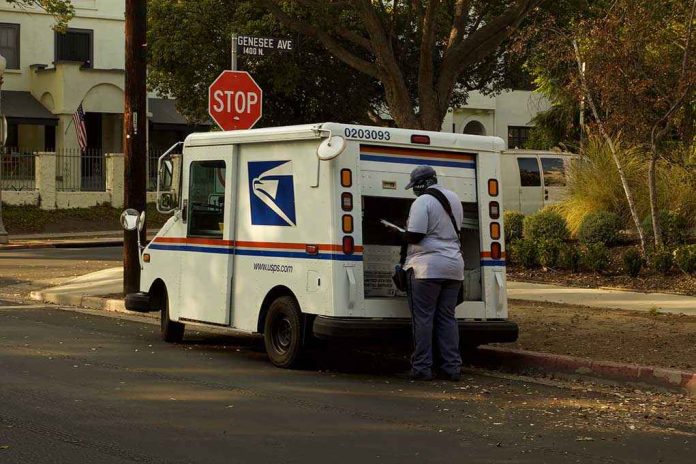
If you’ve received a mysterious package in the mail recently, your personal information may already be in the hands of scammers orchestrating an elaborate fraud scheme targeting American consumers.
Key Takeaways
- Brushing scams involve vendors sending unordered items to create fake verified purchases and post fraudulent positive reviews
- Receiving unsolicited packages signals your personal information has likely been compromised and could be used for identity theft
- The U.S. Postal Service has launched “Project Safe Delivery” to combat mail fraud, resulting in numerous arrests
- Experts recommend reporting suspicious packages, checking financial statements for unauthorized charges, and updating passwords immediately
- Never scan QR codes or engage with unexpected packages as they may contain malicious links
The Growing Threat of Brushing Scams
The U.S. Postal Service is sounding the alarm on an increasingly common fraud scheme known as “brushing” that targets unsuspecting Americans. In these scams, third-party sellers on popular e-commerce platforms send unrequested, typically low-value items to generate what appear to be legitimate transactions. This deceptive practice allows scammers to create fake verified purchases, enabling them to post fraudulent positive reviews that boost their product ratings and visibility on online marketplaces, ultimately increasing their sales to actual customers.
“These scams occur when a customer receives unsolicited packages containing low-cost items like household goods,” said Kelly McNulty, U.S. Postal Inspector.
While receiving free merchandise might seem harmless or even beneficial at first glance, postal authorities warn that these unexpected deliveries actually signal a serious security breach. The very fact that you’ve received an unsolicited package indicates that your personal information – potentially including your name, home address, phone number, and even financial details – has been compromised and is now in the hands of unknown third parties who are actively exploiting it for profit.
Beyond Free Items: The Real Dangers
Though the items received may appear innocuous, the implications extend far beyond unwanted mail. “This is about more than just a package,” warns McNulty. When your personal information is exposed through these schemes, it creates vulnerabilities that extend beyond the initial brushing scam. Criminals can potentially use your compromised data for more serious forms of identity theft, unauthorized financial transactions, or creating fraudulent accounts in your name – all while the original brushing scam serves as a distraction or test run of your information’s validity.
In response to the rising tide of mail-related crimes, the U.S. Postal Service has launched a comprehensive initiative called “Project Safe Delivery.” This program specifically targets mail theft, fraud schemes, and related criminal activities. The project has already yielded significant results, with authorities making numerous arrests connected to these types of mail fraud operations across the country, demonstrating the government’s commitment to protecting Americans from these increasingly sophisticated scams.
Protecting Yourself From Brushing Scams
If you receive a mystery package that you didn’t order, security experts recommend several immediate steps. First, report the suspicious package to the U.S. Postal Inspection Service through their official website or hotline. Next, thoroughly check your financial accounts, credit card statements, and online shopping profiles for any unauthorized charges or suspicious activity. Be particularly vigilant about accounts connected to the websites where the brushing scammer likely obtained your information.
“If you see large discounts on stamps, like 40 to 50% off, it’s probably too good to be true,” said McNulty, highlighting another related postal scam involving counterfeit postage that often accompanies these brushing operations.
Security professionals strongly advise against engaging with the unexpected package in any way that could further compromise your security. Never scan QR codes included with mysterious deliveries, as these may lead to malicious websites designed to harvest additional personal information or install malware on your devices. Similarly, avoid contacting the sender using any information provided with the package, as this could confirm to scammers that your address is valid and actively monitored.
Long-Term Prevention Strategies
Beyond addressing the immediate concern of a suspicious package, consumers should take proactive steps to secure their personal information. Changing passwords for online accounts, particularly those related to shopping platforms, should be your first priority. Consider implementing a password manager to create and store strong, unique passwords for each online service you use, making it significantly harder for criminals to access multiple accounts if one is compromised.
Regularly monitoring your credit reports for unexpected changes or unfamiliar accounts can help you catch identity theft early. Many credit monitoring services offer real-time alerts when new accounts are opened in your name, providing an additional layer of protection. Additionally, consider placing a credit freeze with the major credit bureaus if you suspect your personal information has been seriously compromised, preventing criminals from opening new lines of credit using your identity.
As these scams continue to evolve, remaining vigilant about protecting your personal information is the most effective defense against becoming a victim of brushing scams and the more serious identity theft schemes they often precede. By treating your personal data with the same level of protection you afford to your financial information, you can significantly reduce your vulnerability to these increasingly common mail fraud operations.





